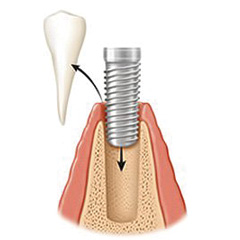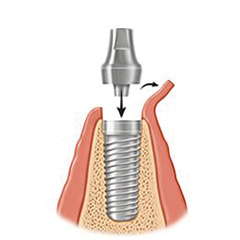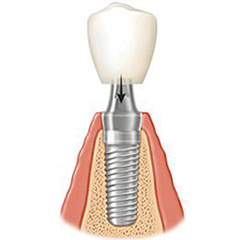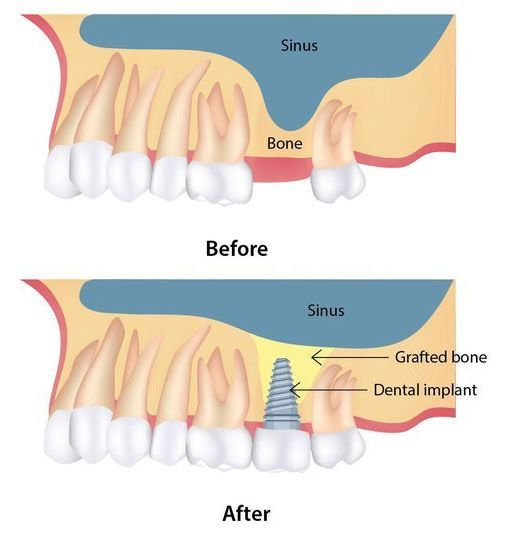Superior implant
solutions
Dental implants typically
have three parts:
Dental implants typically have three parts:
implant
A screw that serves as a root for your new teeth. This is what permanently attaches to your jaw.
abutment
A permanent, but removable by your doctor, connector that supports and holds a tooth or set of teeth.
Crown
The crown
(or Prosthetic Tooth)
This is the part of the tooth that you can see. It’s usually made of zirconium or porcelain for durability and good looks.
Implant treatment process
Implant treatment process
The implant treatment process involves several steps and is designed to replace missing teeth with durable, natural dental implants. The implant treatment process provides a long-lasting, functional and aesthetically pleasing solution for lost teeth. With proper care, dental implants greatly improve the patient’s quality of life so that the patient can speak, eat, and smile confidently.

Step 1
Placement
During this initial stage, a titanium implant is surgically positioned within the jawbone at the site of the missing tooth. The implant serves as an artificial root and is carefully placed for stability and integration.

Step 2
Abutment Mount
Once the healing process is complete, an abutment is attached to the implant. The abutment acts as a connector between the implant and the eventual restoration, such as a crown, bridge, or denture.

Step 3
Implant Crown Completion
In this final step, a custom-made restoration, often a crown, is affixed onto the abutment. This completes the implant procedure, resulting in a functional and natural-looking replacement tooth. It's important to adhere to post-procedure care instructions to ensure the success of the implant and the overall oral health.
What Are Dental Implant
Options for Different Needs?
What Are Dental Implant Options for Different Needs?
Single Implant

When a tooth is lost due to accidents, severe cavities, or gum disease, a single implant can be placed without affecting the neighboring teeth.
Multiple Implants

When two or more teeth are lost due to accidents, cavities, or gum disease, multiple implants can be placed to match the number of missing teeth.
Full Mouth Rehabilitation

This is a method required for patients who need implant treatment for the entire upper or lower set of teeth. A bridge is created by connecting crowns to 6 to 10 implants on each arch to restore all teeth.
This method helps people who need new teeth for their whole upper or lower jaw. In general, the dentist uses six to ten implants on each side of the jaw to make a bridge with crowns, which restores all the teeth. The number of implants and their placement locations vary based on the condition of the jawbone. Full arch implants require a skilled medical team with extensive clinical experience, as they involve complex considerations of upper and lower occlusion and overall balance.

A sinus lift is a procedure where bone is added to the upper jaw in the premolar and molar region to add bone support for the placement of dental implants. This can be due to circumstances in which the bone in the area where teeth are missing naturally begins to shrink over time, the roots of the teeth were originally positioned either very close to or within the sinus cavity, or the vertical height of bone is not sufficient enough to support a dental implant.
As a result of bone loss, the sinuses can expand to occupy the empty space where the roots and bone used to be. With insufficient bone to securely place a dental implant, a sinus augmentation is necessary to move the sinus away to create space for additional bone in the area. Many times, the implant can be placed at the same time. There are a few circumstances where the sinus augmentation needs to be prior to implant placement. This depends on the quantity and quality of bone available in that area.
CASE
Full Mouth Rehabilitation

83 years old·male
(Treatment Time: 10 Months)
Full Mouth Rehabilitation

69 years old·male
(Treatment Time: 5 Months)
Full Mouth Rehabilitation

63 years old·female
(Treatment Time: 16 Months)
Full Mouth Rehabilitation


63 years old·female
(Treatment Time: 16 Months)
Full Mouth Rehabilitation

69 years old·male
(Treatment Time: 5 Months)
Full Mouth Rehabilitation

Full Mouth Rehabilitation




